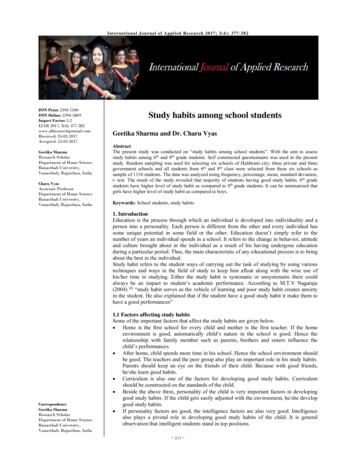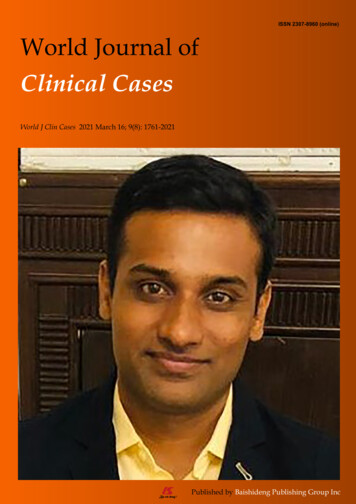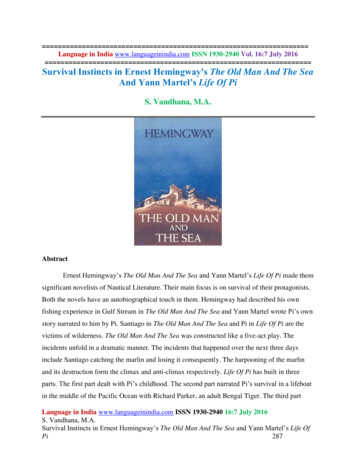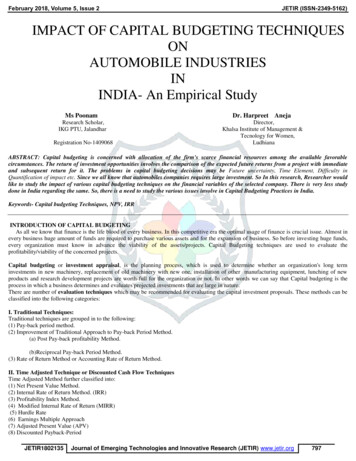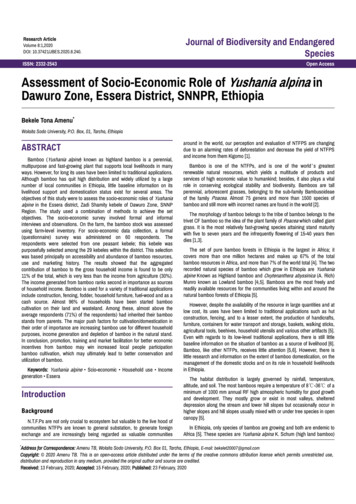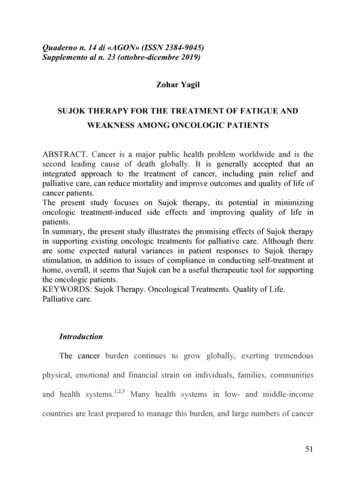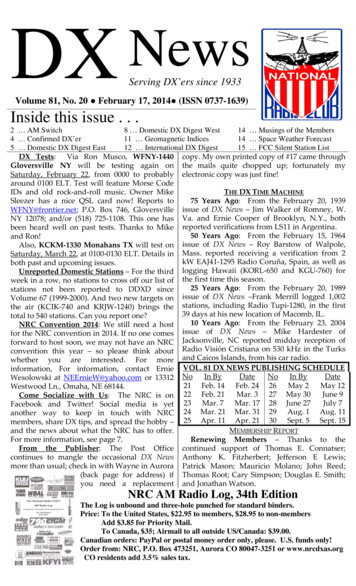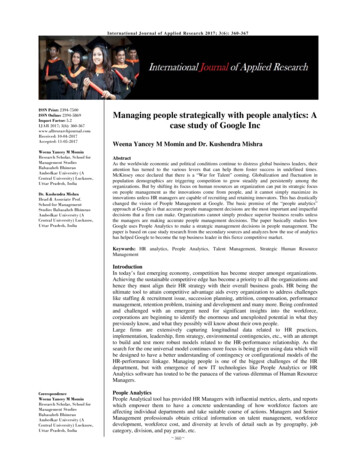
Transcription
Int ern a tio na l Jo u rna l of Appli ed R esea rch 201 7; 3(6): 360 -3 6 7ISSN Print: 2394-7500ISSN Online: 2394-5869Impact Factor: 5.2IJAR 2017; 3(6): 360-367www.allresearchjournal.comReceived: 10-04-2017Accepted: 11-05-2017Weena Yancey M MominResearch Scholar, School forManagement StudiesBabasaheb BhimraoAmbedkar University (ACentral University) Lucknow,Uttar Pradesh, IndiaDr. Kushendra MishraHead & Associate Prof.School for ManagementStudies Babasaheb BhimraoAmbedkar University (ACentral University) Lucknow,Uttar Pradesh, IndiaManaging people strategically with people analytics: Acase study of Google IncWeena Yancey M Momin and Dr. Kushendra MishraAbstractAs the worldwide economic and political conditions continue to distress global business leaders, theirattention has turned to the various levers that can help them foster success in undefined times.McKinsey once declared that there is a “War for Talent” coming. Globalization and fluctuation inpopulation demographics are triggering competition to grow steadily and persistently among theorganizations. But by shifting its focus on human resources an organization can put its strategic focuson people management as the innovations come from people, and it cannot simply maximize itsinnovations unless HR managers are capable of recruiting and retaining innovators. This has drasticallychanged the vision of People Management at Google. The basic premise of the “people analytics”approach at Google is that accurate people management decisions are the most important and impactfuldecisions that a firm can make. Organizations cannot simply produce superior business results unlessthe managers are making accurate people management decisions. The paper basically studies howGoogle uses People Analytics to make a strategic management decisions in people management. Thepaper is based on case study research from the secondary sources and analyzes how the use of analyticshas helped Google to become the top business leader in this fierce competitive market.Keywords: HR analytics, People Analytics, Talent Management, Strategic Human ResourceManagementIntroductionIn today’s fast emerging economy, competition has become steeper amongst organizations.Achieving the sustainable competitive edge has become a priority to all the organizations andhence they must align their HR strategy with their overall business goals. HR being theultimate tool to attain competitive advantage aids every organization to address challengeslike staffing & recruitment issue, succession planning, attrition, compensation, performancemanagement, retention problem, training and development and many more. Being confrontedand challenged with an emergent need for significant insights into the workforce,corporations are beginning to identify the enormous and unexploited potential in what theypreviously know, and what they possibly will know about their own people.Large firms are extensively capturing longitudinal data related to HR practices,implementation, leadership, firm strategy, environmental contingencies, etc., with an attemptto build and test more robust models related to the HR-performance relationship. As thesearch for the one universal model continues more focus is being given using data which willbe designed to have a better understanding of contingency or configurational models of theHR-performance linkage. Managing people is one of the biggest challenges of the HRdepartment, but with emergence of new IT technologies like People Analytics or HRAnalytics software has touted to be the panacea of the various dilemmas of Human ResourceManagers.CorrespondenceWeena Yancey M MominResearch Scholar, School forManagement StudiesBabasaheb BhimraoAmbedkar University (ACentral University) Lucknow,Uttar Pradesh, IndiaPeople AnalyticsPeople Analytical tool has provided HR Managers with influential metrics, alerts, and reportswhich empower them to have a concrete understanding of how workforce factors areaffecting individual departments and take suitable course of actions. Managers and SeniorManagement professionals obtain critical information on talent management, workforcedevelopment, workforce cost, and diversity at levels of detail such as by geography, jobcategory, division, and pay grade, etc. 360
International Journal of Applied ResearchPeople analytics aids to assess the effectiveness of peoplepractices, programs, and processes. It gives a betterunderstanding on how knowledge of social and datasciences help to make more informed and objective peopledecisions.People Analytics is basically about using a data-drivenapproach which drives HR practices, programs andprocesses in a desired manner. The analytical procedure thatranges from identification of metrics to predictive analyticsto experimental research enables to uncover the new insightsto solve most of the people problems and direct the actionsof the HR. At Google, people analytics is used as afoundational building block that enlightens everythingwhich guides the HR to find, grow and keep Googlers.The Google Inc.: Face of InnovationThe People Analytics guides to cover some basics and shedlight on how to begin adopting data-driven decisionapproaches in HR. People analytics is a fast-moving topicenlightening HR practitioner’s in Google a new method andtechnique which keeps them abreast of the advances in thefield of technology and add more content in the future.Google has always been the face of innovation in terms oftechnological advancement. This advancement has enabledGoogle to become one of top business leaders in the market.The top 20 companies in the market has a cap list that couldbe accurately labeled as “old school,” as most of them canattribute their success to being practically half a century oldas they have established long before and their product brandhas been existed since ages and also they have establishedtheir firms through great acquisitions. But Google’s marketsuccess can instead be recognized to what can only bebranded as extraordinary people management practices thathas resulted from the use of its “people analytics. Themission of HR in google is “All people decisions are basedon data and analytics” coined by Prasad Shetty, Director ofPeople Analytics, Google. Being an engineering basedcompany, every area at Google uses data in their dailyoperation including HR department. All people decision atGoogle are based on data.Theoretical Concept: The Analytical Value Chain ModelThis model is basically a measurement tool which takespeople based decision using raw data which is available inthe organization and transforms into insight information. Inthe lowest, it’s the opinion, where basically how all thetraditional HR functions based on the gut feeling and theprevious experience. Next level is the Data and all HRgroups are composed of tons of data within them like howmany people are promoted, who is there in theorganizations, what percentage of the people are leaving thecompany etc. There has been a data with HR forever henceHR and data are not inherently working against each other.But raw form of data is not easily digested and understoodby everyone. The next move up the chain is Metrics whichare counts, ratios that are send out on a regular basis like 4%of managers for full time employee. This are trendable overtime and the help to give little insight about what’shappening in the organization. But over time if these dataare to the people with tons of matrics which tend to getnumb and people tends to take things for granted. The nextup the value chain is Analysis. In this step different data areexamined differently and then draw connection betweenthem and identifies the relationship between them. The nextup is the Insight where all the relationships are studied andtries to draw an action plan. This level influences theManagers to take decisions based on facts and evidence thusfarming new policies, strategy changing the newprogrammes etc. in the last level i.e. the Action level.Source: People Analytics at Google: Using Data to Drive HR Strategy and Action a webinar at Strata JumpstartFig 1: The Analytical Value Chain ValueThe Work planAs Google has gained the extraordinary marketplace successvery young, the need to understand how it has reachedsuccess has become the question of the century. In order tounderstand and interpret its reason for success, a case studyresearch methodology has been adopted and the data hasbeen collected form the secondary sources viz. videos, newsarticles, white papers, webinars etc. The following are themain objectives to uncover the mystery of how Google hasreached the platform of success by using People analytics.Objectives of the Study To identify the matrics that plays a key role tostrategically manage people (parameters) 361
International Journal of Applied Research To identify the tools used in people analytics (analyticaltools)To analyze how Google is making people decisions thatare data driven (post analysis).CASE-I: People Managers (Project Oxygen) – DoManagers matter?Project Oxygen is one of the initiatives of Googles forfinding out if Managers really matter in the organizations.This project was conducted by People and Innovation Lab(PiLab) which is a part of analytics group in Google. Thisgroup consists of social scientist focused on solving a longerterm questions and problems and they tackle things that arenot immediately being asked currently by business but aboutthe questions and problems that can have a betterunderstanding which requires an in depth analysis. Hencetheir mission is to conduct an innovative research thattransforms the traditional practices.Project Oxygen is about going back to the myth that startedin the early days of Google. As Google being theengineering company, people manager has a very less statusin the organization. So back in the early days of Google, thefounders initiated that they really did not need Managers inthe company as the company is all about technicalinnovations. All the managers were let go and made everyindividual a contributor again. But this action did not workout well, and the Managers were brought back. But thestigma remains that Managers are really not doing any workas there was no proven impact. Hence Pilab took up theproject to analyze if Managers really matter in anorganization.Firstly they identified the data sources that already existedinside the organization. The two most common keyindicators that most companies have are performance reviewand employee survey. Then they tried to understand thesetwo indicators, as they gave two different signals. Theperformance review of Managers is a review from the top –down approach and employee survey reviews the managersform the bottom – up approach hence it is their own directreports which is reviewing them. Now Pilab has plottedthese two scores in a graph; one in X axis and other in Yaxis and they analyzed where the managers fell in this plot.At first glance people are tightly clustered giving the viewthat people are doing pretty well in Google. But thisscenario did not help to answer the question if Managersreally matter?Then the Pilab cut the data into top quartile and bottomquartile and they looked at the best if you will managers andthe worst managers. And then they looked at how thesesmanagers preforms, based on their teams in turn of teamproductivity, how happy they are with the company, howlikely the employees were to stay with the company. Theresult were astounding, even though there was a tightlyclustered bunch there was a huge differences between themlike the managers impact on each activity. After regressionanalysis, it was able to parse out these differences amongstthe managers. After the result it was startling to see thatmanagers seem to have the impact on different fields. ThusPiLab has proven the issue that Managers do Matter in anorganization but they did not stop the experiment here. Theydid not just want this exercise to be just academics but alsohelp managers who are struggling get better and helpmanagers improve. But the research was incomplete as theydid not have the knowledge on how these managers got tobe good. Hence Google made PiLab dig deeper tounderstand what makes a good managers “good”.So in order to have an in depth understanding Pilabconducted two different qualitative studies. First they starteddoing the award called “The Great Managers Award” andinorder to nominate someone for this award the employeesneed to write up examples of behaviors of what they haddone for which they are qualified for this award. Once allthe data has been collected PiLab scientifically studied thiswrite ups and coded them to find out what were commonexamples of qualities of a great manager. Simultaneouslythey also did a double blind interview study where theyinterviewed both great managers and not as great managerswhere neither the interviewer nor the manager knew whichpocket they are in and they coded this transcript as well tounderstand better what were the common kind of things thatthe great managers were doing comparing to the kind ofthings that not so great managers are doing.Source: People Analytics at Google: Using Data to Drive HR Strategy and Action a webinar at Strata JumpstartFig 2: Indicators for Qualitative studies by PiLab at Google.Based on this exercise PiLab came up with the best 8behaviors that great managers must possess. And also theyidentified 3 pitfalls that are being faced by strugglingmanagers.The eight (8) Behaviors that great managers at Googlepossess are as follows: 362
International Journal of Applied ResearchSource: People Analytics at Google: Using Data to Drive HR Strategy and Action a webinar at StrataJumpstart And the 3 Pitfalls that causes the managers to struggle:Fig 3: 8 behaviors of Successful Managers @ Google.Source: People Analytics at Google: Using Data to Drive HR Strategy and Action a webinar at Strata JumpstartFig 4: 3 Pitfalls – what causes managers to struggle?Taki
CASE-I: People Managers (Project Oxygen) – Do Managers matter? Project Oxygen is one of the initiatives of Googles for finding out if Managers really matter in the organizations. This project was conducted by People and Innovation Lab (PiLab) which is a part of analytics group in Google. ThisAuthor: Weena Yancey M Momin, Kushendra MishraPublish Year: 2017
